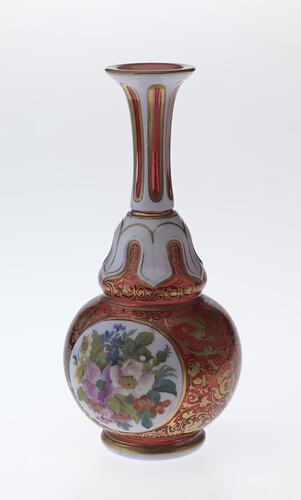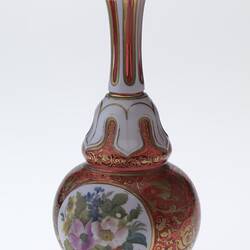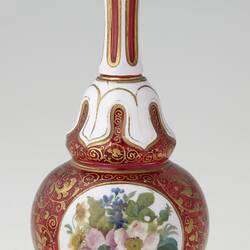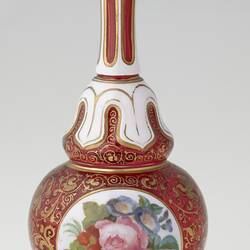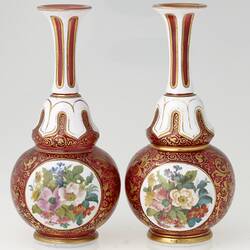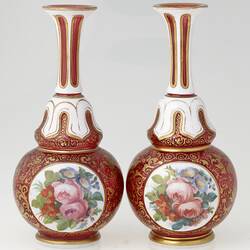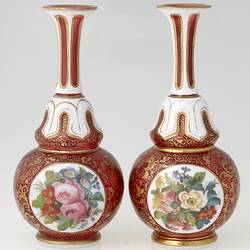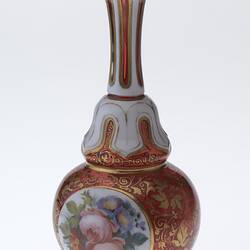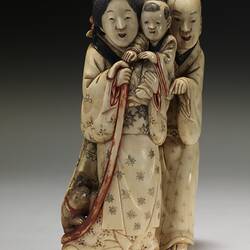Summary
Ruby red and white blown glass vase (one of a pair) with gilt arabesque style tendril design, and enamelled floral panels.
Count Harrach of Neuwelt (Nový Svet, now Harrachov) presented the largest display of Bohemian glass at the Melbourne International Exhibition. Effusively described in the description of the Austro-Hungary Court, Harrach's display was awarded a First Order of Merit (gold medal). Examples of glassware similar to these vases were noted among Harrach's exhibits at the 1880 Melbourne International Exhibition. As a journalist for Adelaide's South Australian Regiter observed, 'The specimens in ruby and in gold and white enamel on ruby ground are exceedingly charming. This rich and attractive tint is produced by a mixture of gold with the material used.'
Glass workshops were established in Harrachov in 1712 by Elias Müller, who had gained permission from the then Count, Alois Raimund von Harrach. The Harrach family acquired the glass works in 1754, and the growth of the glass industry in the region is partly due to the long-standing reputation of the factory's output. Glass blanks manufactured at the Harrach factory were used by a number of the other major Bohemian glass manufacturers and designers in the late nineteenth century.
The Harrach glass works were privatised in 1993, and continue today under the name Sklarna Novosad and Syn (Novosad and Sons) Bohemia Harrachov.
Physical Description
Red blown glass vase with fluted neck, profusely decorated with gilt tendil and foliate motifs and painted floral still life panels on opposing sides of the body. Rim is flared, and the neck drops to a waisted shoulder above a bulbous body on a small foot.
More Information
-
Collection Names
-
Collecting Areas
-
Acquisition Information
Cultural Gifts Donation from Dr Will Twycross, 23 Jan 2009
-
Acknowledgement
Donated through the Australian Government's Cultural Gifts Program
-
Place & Date Made
-
Place & Date Exhibited
Royal Exhibition Building (REB), Nicholson Street, Carlton, Greater Melbourne, Victoria, Australia, 1880-1881
-
Collector
Mr John Twycross, Elsternwick, Greater Melbourne, Victoria, Australia, 1881
-
Inscriptions
Handwritten numbers on underside in black. Number 5 on white ground. Cross hatching in glass on underside of foot rim: X III (?) The etched numeral is of a European or continental shape.
-
Classification
Royal exhibition building, International exhibitions, Exhibition heritage
-
Category
-
Discipline
-
Type of item
-
Overall Dimensions
80 mm (Width), 165 mm (Height)
-
Maximum dimensions
160 mm (Height), 73 mm (Outside Diameter)
Measurement From Conservation.
-
References
[Link 1] 'Austria', Argus (Exhibition Supplement), Monday, 11 October 1880, p.21 'The Austrian Court', South Australian Register, Wednesday, 27 October 1880, p.5 Petrova, Sylva, and Olivie, Jean Luc (ed), Bohemian Glass, 1400-1989, Harry N. Abrams Inc, New York, 1990.
-
Keywords
Decorative Arts, Exhibitions: Melbourne International, 1880-1881, Glass, Royal Exhibition Building
